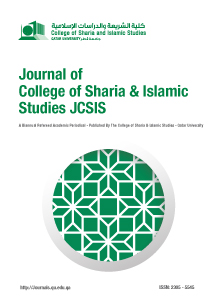Rapprochement between Sunnīs and Imāmīs during the Crusades
Abstract
The Imāmī Shī‘a of Syria stood along with the Sunnīs as one group against the Franks, rather than as followers of different religious traditions. This article traces the rapprochement between the Sunnī and the Imāmī Shī‘a in the face of the Franks. Examples that were invoked to make the point here include the Imāmīs of Tripoli and Aleppo and the Imāmī vizier of the Fatimids, Ṭalā’i‘ Ibn Ruzzayk. Three factors seem to have underlined this sense of unity: doctrinal nearness, geographic proximity, and the political quietism of medieval Imāmism. Saladin’s relations with the Imāmīs are also invoked here. Being more pragmatic than his predecessor Nūr Al-Dīn, Saladin valued winning hearts and minds as much as winning battles. He successfully adopted a containment policy that was based on winning the Syrian Imāmīs and building a broad alliance with them against the Franks.
Metrics
##plugins.themes.bootstrap3.article.details##
IslamSyriaCrusadesSunnismShī‘aImāmism
• Al-Dhahabī, Shams Al-Dīn. Siyar A‘lām Al-Nubalā’. (In Arabic), (Beirut: Mu’assasat Al-Risāla, 1993).
• ---. Al-‘Ibar fī Khabār man Ghabar. (In Arabic), (Beirut: Dār al Kutub Al-‘Ilmiyyya, n.d.)
• ---. Tārīkh Al-Islām, (In Arabic), (Beirut: Dār Al-Kitāb Al-‘Arabī, 1987.)
• Al-Ghazālī, Abū Ḥāmid. Faḍā’iḥ Al-Bāṭiniyya, (In Arabic), (Kuwait: Dār Al-Kutub Al-Thaqāfiyya, n.d.)
• Al-Ghazzi, Kāmil Ibn Ḥusayn. Nahr Al-Dhahab fī Tārīkh Ḥalab. (In Arabic), (Aleppo: Dār Al-Qalam,
1998).
• Al-Ḥamawī, Yāqūt. Mu‘jam Al-Buldān. (In Arabic), (Beirut: Dār ṣādir, 1995).
Al-Maqdisī, Abū Shāma. ‘Uyūn Al-Rawḍatayn fī Akhbār Al-Dawlatayn. (In Arabic), (Beirut: Mu’assasat
Al-Risāla, 1997).
• Al-Maqdisī, Muḥammad Ibn Aḥmad. Aḥsan Al-Taqāsīm fī Ma‘rifat Al-Aqālīm, (In Arabic), (Cairo:
Madbūlī, 1991.
• Al-Maqrīzī, Aḥmad Ibn ‘Ali. Itti‘āẓ Al-Ḥunafā’ bi Akhbār Al-A’imma Al-Fāṭimiyyīn Al-Khulafā’, (In
Arabic), (Cairo: Lajnat Iḥyā’ Al-Turāth, 1996.)
• Al-Murrakshī, Muḥammad Ibn ‘Abd Al-Malik. Al-Sifr Al-Khāmis min Kitāb Al-Dhayl wa Al-Takmila li
Kitāb Al-Tawṣīl wa Al-Ṣila, (In Arabic), (Beirut: Dār Al-Thaqāfa, 1965.)
• Comnena, Anna. The Alexiad. Translated by Elizabeth A. S. Dawes. Cambridge, Ontario: Parentheses
Publications, 2000.
• Fulcher of Chartres, A History of the Expedition to Jerusalem, 1095-1127, trans. Frances Rita Ryan. New
York: W.W. Norton and Company, 1973.
• Gibb, H. A. R. Zengi and the Fall of Edessa.” In The First Hundred Years. Vol. I of A History of the
Crusades. Edited by M. W. Baldwin. Madison, Wisconsin: University of Wisconsin Press, 1969. Pp. 449-
462.
• Grousset, René. Histoire des croisades et du Royaume Franc de Jérusalem. Paris: Perrin, 1991.
• Hillenbrand, Carole. The Crusades: Islamic Perspectives. Edinburgh: Edinburgh University Press, 2009.
• Ibn Al‘Adīm, Kamāl Al-Dīn. Bughyat Al-Ṭalab fī Tarīkh Ḥalab, (In Arabic), (Damascus: Dār Al-Fikr,n.d.)
• ---. Zubdat Al-Ḥalab fī Tarīkh Ḥalab. (In Arabic), (Damascus: Dār Al-Kitāb Al-‘Arabī, 1997).
• Ibn Al-Athīr, ‘Izz Al-Dīn. Al-Kāmil fi Al-Tārīkh, (In Arabic), (Beirut: Dar Al-Kutub Al-‘Ilmiyya, 1993).
• Ibn Al-‘Ibrī, Gregorius. Tārīkh Mukhtaṣar Al-Duwal, (In Arabic), (Beirut: Dār Al-Sharq, 1992).
• Ibn Al-Qalānisī, Ḥamza. Dhayl Tarīkh Dimashq. (In Arabic), (Damascus: Dār Ḥassān, 1983).
• Ibn Al-Wardī, Zayn Al-Dīn. Tarīkh Ibn Al-Wardī. (In Arabic), (Beirut: Dār Al-Kutub Al-‘Ilmiyya, 1996).
• Ibn Baṭṭūṭa, Muḥammad. Riḥlat Ibn Baṭṭūṭa. (In Arabic), (Rabat: Akādimiyyat Al-Mamlaka Al-
Maghribiyya, 1996).
• Ibn Jubayr, Muḥammad. Riḥlat Ibn Jubayr. (In Arabic), (Beirut: Dār Al-Hilāl, n.d.).
• Ibn Kathīr, Ismā‘īl. Al-Bidāya wa Al-Nihāya. (In Arabic), (Beirut: Maktabat Al-Ma’ārif, n.d.).
• Ibn Khallikān, Aḥmad. Wafayāt Al-A‘yān wa Anbā’ Abnā’ Al-Zamān. (In Arabic), (Beirut: Dār Al-Thaqāfa,
n.d.).
• Ibn Khaldūn, ‘Abd Al-Raḥmān. Tārīkh Ibn Khaldūn. (In Arabic), (Beirut: Dār Al-Qalam, 1984).
• Ibn Shaddād, Bahā’ Al-Dīn. Al-Nawādir Al-Sulṭaniyya wa Al-Maḥāsin Al-Yusufiyya, aw Sirat Ṣalāh Al-
Dīn. (In Arabic), (Cairo: Maktabat Al-Khanjī, 1994).
• Ibn Shaddād, ‘Izz Al-Dīn. Al-A‘lāq Al-Khaṭīra fī Dhikr Umarā’ Al-Shām wa Al-Jazīra. (In Arabic),
(Damascus: Syrian Ministry of Culture, 1991).
• Ibn Taghrī Bardā, Yūsuf. Al-Nujūm Al-Zāhira fī Mulūk Miṣr wa Al-Qāhira. (In Arabic), (Cairo: Egyptian
Ministry of Culture, n.d.)
• Khusrū, Nāṣir. Safar-Nāmah, trans. Yaḥya Al-Khashshāb. (In Arabic), (Beirut: Dār Al-Kitāb Al-Jadīd,
1983).
• Maalouf, Amin. The Crusades through Arab Eyes. Translated by Jon Rothschild. New York: Schocken
Books, 1985.
• Martin, Vanessa. Creating an Islamic State: Khomeini and the Making of New Iran. London, I.B. Tauris,
2000.
• McEoin, Denis. “Aspects of Militancy and Quietism in Imāmī Shī‘ism.” Bulletin of the British Society for
Middle Eastern Studies, 11, no. 1 (1984): 18-27.
• Neocleous, Savvas. “The Byzantines and Saladin: Opponents of the Third Crusade?” Crusades, Vol. 1,
(2010): 87-106.
• Nizām Al-Mulk. Siyāsat Nāmeh. (In Arabic), (Doha: Dār al-Thaqāfah, 1986).
• Runciman, Steven. A History of the Crusades. New York: Cambridge University Press, 1951.
• Stevenson, W. B., The Crusaders in the East: A Brief History of the Wars of Islam with the Latins in Syria
during the Twelfth and Thirteenth Centuries. London: Cambridge University Press, 1907.
• William of Tyre, A History of Deeds Done Beyond the Sea. Translated by Emily Atwater Babcock and A.
C. Krey. New York: Columbia University Press, 1943.


